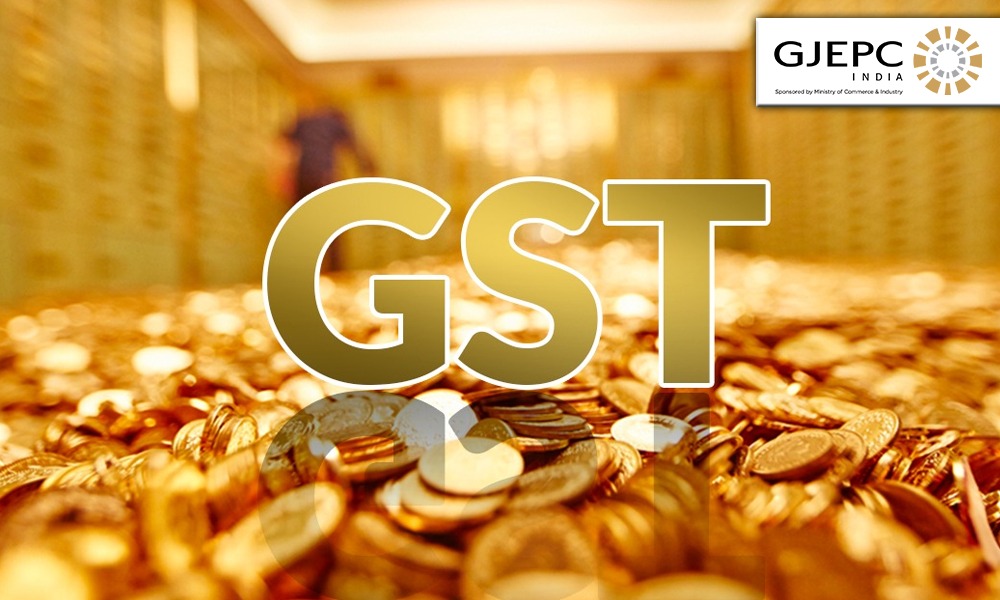National News
GST reforms a bold and timely step to ease pressure on export chains: GJEPC

- IGST reduced from 18% to Nil on Natural Cut and Polished Diamonds up to 25 cents (1/4 carats) imported under Diamond Imprest Authorization Scheme
- Reduced GST on jewellery boxes from 12% to 5%
The Gem & Jewellery Export Promotion Council (GJEPC) has warmly welcomed the GST reforms announced at the 56th GST Council meeting held on 3rd September in New Delhi under the chairpersonship of Hon’ble Union Finance & Corporate Affairs Minister, Smt Nirmala Sitharaman. The rationalisation of GST rates across multiple sectors reflects the Government’s commitment to stimulating domestic demand, easing cost pressures, and enhancing the competitiveness of Indian industry.
For the diamonds and jewellery sector, the reforms bring significant relief. The Council’s decision to exempt imports of natural cut and polished diamonds up to 25 cents under the Diamond Imprest Authorisation Scheme (DIAS) from IGST (previously 18%) will ease working capital pressures and support manufacturers and exporters engaged in small-diamond processing. In addition, the reduction of GST on jewellery boxes from 12% to 5% will lower costs for retailers and exporters, while making packaging and gifting more affordable for consumers—benefiting both businesses and buyers alike.

Kirit Bhansali, Chairman, GJEPC, said, “We welcome the GST reforms announced under the guidance of Hon’ble Finance Minister Smt Nirmala Sitharaman. These measures will stimulate domestic demand and provide a cushion to our export supply chains, which are under pressure due to global challenges. The diamonds and jewellery sector remains committed to ensuring that the benefits, including reduced costs for jewellery boxes, are transparently passed on to Indian consumers, reinforcing trust and supporting long-term industry growth.”
Rajesh Rokde
Chairman, GJC
The current GST reforms (GST 2.0) offers no direct and immediate relief to gems and jewellery exporters against. Importantly, the gems and jewellery sector was excluded from the latest reforms, which reduced the number of GST slabs from four to two (5% and 18%), eliminated the 12% and 28% brackets, and introduced a 40% rate for luxury goods. As a result, the reforms do not offset the adverse impact of U.S. tariffs, since input costs and compliance burdens remain unchanged. However, by focusing on stimulating consumption, the GST changes may support the gems and jewellery sector indirectly over the longer term. The new rates, effective from September 22, are expected to boost consumption, with the overall fiscal impact of the overhaul estimated at around Rs 50,000 crore.


Avinash Gupta
Vice Chairman – GJC
As expected, the GST rate for the gem and jewellery sector remains unchanged at 3%. The GJC has consistently represented to the government that, given the sharp rise in gold prices and in line with revenue-neutral principles, the GST rate should ideally be reduced to 1%–1.25%.
The introduction of the next-generation GST reforms, streamlining the system into just two slabs—5% and 18%—alongside the proposed income tax reforms in the budget, is set to provide a significant boost to domestic consumption. This, in turn, will benefit the gem and jewellery sector by driving higher sales, particularly during the upcoming festive season.
The industry views this reform as a timely step that will brighten the festive outlook and ensure a truly prosperous Diwali. For this initiative, we extend our gratitude to our Honourable Prime Minister and Finance Minister for bringing in such a much-needed reform at the right time.
Saiyam Mehra
IPC- GJC and Director – Unique Chains and Jewels Ltd
The next-gen GST reforms mark a pivotal moment for India’s consumption-driven economy. By streamlining tax slabs and easing the burden on essential goods, the government has empowered consumers with greater purchasing power. For the gem and jewellery industry, this translates into renewed optimism—where jewellery is not just a luxury, but a preferred investment and cultural expression. We believe this reform will unlock fresh demand, especially from emerging markets and younger buyers seeking value and authenticity.


Prabhat Ranjan, Senior Director, Nexdigm, shares insights on sectoral impact of GST Council’s latest reforms The GST Council has retained the 3% rate on gold. This stability is crucial in a sentiment-driven market where seasonal demand peaks during weddings and festivals. By avoiding volatility, the Council discourages informal trade and sustains confidence in the organized sector.
Sometimes, stability is the strongest reform. By keeping GST on gold unchanged, the Council has preserved predictability in a market deeply tied to culture and sentiment. This move reassures consumers and jewellers alike, while ensuring the organized sector continues to flourish.
These reforms, combined with GST reductions in allied sectors such as handicrafts, leather goods, and packaging, will further strengthen India’s diamonds and jewellery ecosystem. By lowering operational costs, enhancing affordability, and boosting global competitiveness, they reinforce India’s position as a leading hub for diamond processing, jewellery design, and exports.
GJEPC appreciates the Government’s consultative approach and is confident that these measures will deliver broad-based benefits, supporting both domestic growth and export resilience for the Indian diamonds and jewellery sector.
National News
Gold loan NBFC stocks face pressure as gold prices decline

Gold loan NBFC stocks faced pressure as gold prices crashed, with Muthoot Finance and Manappuram Finance dropping 3% and 1.45%. Despite recent declines, both stocks show solid year-to-date gains of around 49% and 50%, respectively. Shares of Muthoot Finance slipped 4.29 percent to Rs 3,134.20 apiece on the NSE. The stock has declined for three straight sessions, losing nearly 6 percent during the period. Manappuram Finance also fell 2.8 percent to Rs 277.90 per share.
Gold prices eased for the third consecutive day as investors booked profits after a recent rally. Globally, the metal edged lower towards the $4,000-an-ounce mark amid concerns that its sharp gains had become overstretched. Weakness in gold prices typically weighs on gold financing companies as the value of collateral declines, impacting loan margins. Short-term challenges include potential slowdowns in loan disbursements and temporary margin pressure.
Gold loan NBFC stocks are facing pressure as gold prices have declined for three consecutive days. Muthoot Finance dropped 4.29% to Rs 3,134.20, losing nearly 6% over three sessions, while Manappuram Finance fell 2.8% to Rs 277.90. This decline comes as investors booked profits after gold’s recent rally toward the $4,000-an-ounce mark, with concerns that prices had become overstretched.
The connection between falling gold prices and these stocks is straightforward. Gold loan NBFCs lend money using gold jewelry as collateral, typically advancing around 75% of the gold’s value. When gold prices fall, the collateral backing their existing loans becomes less valuable, which squeezes their safety margins and creates potential risks. They may need to ask borrowers for additional collateral or close out some positions if the loan-to-value ratios become unfavorable.
Beyond the immediate risk concerns, falling gold prices also hurt the growth prospects of these companies. Lower prices mean they can only disburse smaller loans against the same quantity of gold, which directly impacts their ability to grow their loan books. Additionally, customers become hesitant to pledge their gold when prices are declining, preferring to wait for better valuations. This combination reduces both the size and volume of new loans.
However, the recent decline needs to be viewed in context. Despite the current pressure, both Muthoot Finance and Manappuram Finance are still showing impressive year-to-date gains of around 49-50%. This means the recent weakness represents a modest correction within a much larger uptrend. The stocks have performed exceptionally well throughout the year, and this pullback follows a period of strong gains.
Looking ahead, the key question is whether gold prices will stabilize or continue declining. Short-term challenges include potential slowdowns in loan disbursements and temporary margin pressure. However, gold loan NBFCs have weathered gold price volatility before, and their business model remains fundamentally sound with typically low non-performing assets. India’s deep cultural connection to gold ensures sustained demand for gold-backed financing regardless of short-term price movements. For investors, this situation could represent either a buying opportunity or a warning sign, depending on their view of gold’s longer-term trajectory.
-

 National News1 week ago
National News1 week agoSenco Gold & Diamonds launches affordable 9k gold jewellery starting under ₹7,000, a Game-changer amid fluctuating gold prices this Dhanteras
-

 GlamBuzz1 day ago
GlamBuzz1 day agoAbaran Jewellers conducts grand reopening of flagship showroom at J.P. Nagar South Bangalore
-

 National News7 hours ago
National News7 hours agoGold loan NBFC stocks face pressure as gold prices decline
-

 JB Insights1 week ago
JB Insights1 week agoJewellery industry optimistic despite rising gold prices










